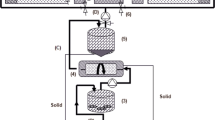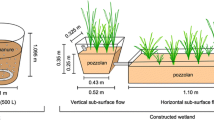Abstract
The overuse of pig slurry for fertilization purposes could involve an environmental risk. Pig slurry has been scarcely treated using constructed wetlands and stabilization ponds. Further information on hydraulic retention time comparison at full-scale in farms is desired. This survey aims to optimize a low-cost system comparing two hydraulic retention times (3 and 7 days) to purify pig slurry. Physical, chemical and microbial parameters were tested. A mechanical separator provided homogenous influent to feed the constructed wetland. Seven days of retention presented higher COD and N removal while 3 days of retention was more effective to remove TP and SO4 2− in the constructed wetland. However, higher removal efficiencies were registered performing 7 days of retention for Mn (148.1 %), TP (113.4 %), KN (102.6 %), COD (102.5 %), NH4 +-N (94.0 %), TC (87.9 %), Cu (64.2 %), FS (47.4 %), NO3 − (36.6 %), Ca2+ (32.1 %), and Br− (26.0 %) in the whole system, pointing out the positive effect of the storage pond. Though the main potential pollutants were effectively reduced, parameters such as Fe, SO4 2−, SS, Zn and NO2 − increased after purification.


Similar content being viewed by others
References
Anderson, C. J., Mitsch, W. J., & Nairn, R. W. (2005). Temporal and spatial development of surface soil conditions at two created riverine marshes. Journal of Environmental Quality, 34(6), 2072–2081.
Antolín, M. C., Pascual, I., García, C., Polo, A., & Sánchez-Díaz, M. (2005). Growth, yield and solute content of barley in soils treated with sewage sludge under semiarid Mediterranean conditions. Field Crops Research, 94, 224–237.
APHA, AWWA, WEF. (2012). Standard Methods for examination of water and wastewater. Washington: 22nd American Public Health Association. http://www.standardmethods.org/ Accessed 15 Jan 2016.
Bayo, J., Gómez-López, M. D., Faz, A., & Caballero, A. (2012). Environmental assessment of pig slurry management after local characterization and normalization. Journal of Cleaner Production, 32, 227–235.
Bock, E., Koops, H., & Harms, H. (1989). Nitrifying bacteria. In H. G. Schlegel & B. Bowien (Eds.), Autotrophic Bacteria (pp. 81–96). Berlin: Springer.
Bonmati, A., & Flotats, X. (2003). Air stripping of ammonia from pig slurry: characterization and feasibility as a pre- or post-treatment to mesophilic anaerobic digestion. Waste Management, 23, 261–272.
Borin, M., Politeo, M., & De Stefani, G. (2013). Performance of a hybrid constructed wetland treating piggery wastewater. Ecological Engineering, 51, 229–236.
Caballero-Lajarín, A. M. (2013). Sistema de depuración de aguas residuales de origen ganadero. Humedales artificiales. Doctoral tesis. Volumen 1. Universidad Politécnica de Cartagena. Cartagena. http://repositorio.bib.upct.es/dspace/handle/10317/3891/ Accessed 7 Nov 2015.
Caballero-Lajarín, A.M., Zornoza, R., Faz, A., Lobera, J.B, Muñoz, M.A., Domínguez-Oliver, S.G. (2015). Combination of low cost technologies for pig slurry purification under semiarid Mediterranean conditions. Water, Air and Soil Pollution, 226-341.
De Godos, I., Blanco, S., García-Encina, P. A., Becares, E., & Muñoz, R. (2009). Long-term operation of high rate algal ponds for the bioremediation of piggery wastewaters at high loading rates. Bioresource Technology, 100(19), 4332–4339.
Delgado, M., Porcel, M., Miralles de Imperial, R., Bellido, N., Bigeriego, M., Beltrán, E., & Calvo, R. (1999). Mineralización del nitrógeno procedente de residuos orgánicos. Revista Internacional de Contaminación Ambiental, 15(1), 19–25.
Doherty, L., Zhao, Y., Zhao, X., & Wang, W. (2015). Nutrient and organics removal from swine slurry with simultaneous electricity generation in an alum sludge-based constructed wetland incorporating microbial fuel cell technology. Chemical Engineering Journal, 266, 74–81.
Domingos, S., Germain, M., Dallas, S., & Ho, G. (2007). Nitrogen removal from industrial wastewater by hybrid constructed wetland systems. Perth: 2nd IWA-ASPIRE Conference and Exhibition. 28 October–31 November.
Duchaufour, P. (1970). Precis de Pedologie. Paris: Masson.
EEC. (1991). Council Directive of 12 December 1991 Concerning the Protection of Waters Against Pollution by Nitrates from Agriculture Sources (91/676/ EEC).
Fernandes, H., Viancelli, A., Martins, C. L., Antonio, R. V., & Costa, R. H. (2013). Microbial and chemical profile of a ponds system for the treatment of landfill leachate. Waste Management, 33, 2123–2128.
Fernandes, J. P., Marisa, C., Almeida, R., Pereira, A. C., Ribeiro, I. O., Reis, I., Carvalho, P., Clara, M., Basto, P., & Mucha, A. P. (2015). Microbial community dynamics associated with veterinary antibiotics removal in constructed wetlands microcosms. Bioresource Technology, 182, 26–33.
Fynlayson, C. M., & Chick, A. J. (1983). Testing the potential of aquatic plants to treat abattoir effluent. Water Research, 17, 415–422.
Gerritse, R. G. (1993). Prediction of travel times of phosphate in soils at a disposal site for wastewaters. Water Research, 27, 263–267.
Gómez-Garrido, M., Martínez-Martínez, S., Faz Cano, A., Büyükkilif-Yanardag, A., & Arocena, J. M. (2014). Soil fertility status and nutrients provided to spring barley (Hordeum distichon L.) by pig slurry. Chilean Journal of Agricultural Research, 74(1), 73–82.
Hiley, P. (2003). Performance of wastewater treatment and nutrient removal wetlands. In U. Mander & P. Jenssen (Eds.), Constructed Wetlands for Wastewater Treatment in Cold Climates, (Reedbeds) in Cold Temperature Climates (pp. 1–18). Southampton: WIT Press.
Kadlec, R., & Knight, R. L. (1996). Treatment Wetlands. Boca Raton: Lewis Publishers.
Kadlec, R. H., & Wallace, S. (2008). Treatment Wetlands (2nd ed.). Boca Raton: CRC Press.
Knight, R. L., Payne, V. W. E., Jr., Borer, R. E., Clarke, R. A., Jr., & Pries, J. H. (2000). Constructed wetlands for livestock wastewater management. Ecological Engineering, 15, 41–55.
Larse, T. A., Lienert, J., Joss, A., & Siegrist, H. (2004). How to avoid pharmaceuticals in the aquatic environment. Journal of Biotechnology, 113, 295–304.
MAGRAMA. (2015). Anuario de Estadística del MAGRAMA 2013. http://www.magrama.gob.es/es/estadistica/temas/publicaciones/anuario-de-estadistica/ Accessed 15 May 2015.
Mashauri, D. A., Mulungu, D. M. M., & Abdulhussein, B. S. (2000). Constructed wetland at the University of Dar Es Salaam. Water Research, 34, 1135–1144.
Massé, D., Gilbert, Y., & Topp, E. (2011). Pathogen removal in farm-scale psychrophilic anaerobic digesters processing swine manure. Bioresource Technology, 102, 641–646.
Molina-Grima, E. (1999). Microalgae mass cultura methods. In: Flickinger, M.C., Drew, S.W. (Eds.), Encyclopedia of bioprocess technology: fermentation, biocatalysis and bioseparation. John Wiley & Sons, pp. 1753-1769. http://www.wiley.com/legacy/products/ Accessed 12 June 2016
Pastor, R., Benqlilou, C., Paz, D., Cardenas, G., Espuña, A., & Puigjaner, L. (2003). Design optimization of constructed wetlands for wastewater treatment. Resources, Conservation and Recycling, 37(3), 193–204.
Peters, J., Combs, S. M., Hoskins, B., Jarman, J., Kovar, J. L., Watson, M. E., Wolf, A. M., & Wolf, N. (2003). Recommended Methods of Manure Analysis (A3769). Madison: Soil Science Department, University of Wisconsin.
Phillips, V. R., Scholtens, R., Lee, D. S., Garland, J. A., & Sneath, R. W. (2000). A review of methods for measuring emission rates of ammonia from livestock buildings and slurry or manure stores. Part 1: assessment of basic approaches. Journal of Agricultural Engineering Research, 77, 355–364.
Polprasert, C., Khatiwada, N. R., & Bhurtel, J. (1998). Design model for COD removal in constructed wetlands based on biofilm activity. Journal of Environmental Engineering, 124, 838–843.
Polprasert, C., & Kittipongvises, S. (2011). 4.10 - Constructed Wetlands and Waste Stabilization Ponds. In P. Wilderer (Ed.), Treatise on Water Science (pp. 277–299). Oxford: Elsevier.
Puigagut, J., Vilaseñor, J., Salas, J. J., Béceras, E., & García, J. (2007). Subsurface flow constructed wetlands in Spain for the sanitation of small communities: a comparative study. Ecological Engineering, 30, 312–319.
Rai, U. N., Upadhyay, A. K., Singh, N. K., Dwivedi, S., & Tripathi, R. D. (2015). Seasonal applicability of horizontal sub-surface flow constructed wetland for trace elements and nutrient removal from urban wastes to conserve Ganga River water quality at Haridwar, India. Ecological Engineering, 81, 115–122.
Reddy, K. R., & Patrick, W. H. (1984). Nitrogen transformations and loss in flooded soils and sediments. Critical Review in Environmental Control, 13, 273–309.
Ros, M., García, C., & Hernández, T. (2006). A full scale study of treatment of pig slurry by composting: kinetic changes in chemical and microbial properties. Waste Management, 26, 1108–1118.
Sánchez, M., & González, J. L. (2005). The fertilizer value of pig slurry. I. Values depending on the type of operation. Bioresource Technology, 96, 1117–11123.
Scholz, M. (2006). Wetland Systems to Control Urban Runoff. Amsterdam: Elsevier.
Science for the Environment Policy (2013). Nitrogen Pollution and the European Environment Implicationsfor Air Quality Policy. European Comission (Eds). Science Communication Unit, University of the West of England (UWE), Bristol.
Sehar, S. S., Naeem, S., Perveen, I., Ali, N., & Ahmed, S. (2015). A comparative study of macrophytes influence on wastewater treatment through subsurface flow hybrid constructed wetland. Ecological Engineering, 81, 62–69.
SIAM. (2016). Sistema de información agrario de Murcia. http://siam.imida.es/apex/f?p=101:46:1944788602090369 Accessed 1 July 2016.
Shapiro, S. S., & Wilk, M. B. (1965). An analysis of variance test for normality (complete samples). Biometrika, 3-4, 591–611.
Steer, D., Fraser, D. L., Boddy, J., & Seibert, B. (2002). Efficiency of small constructed wetlands for subsurface treatment of single-family domestic effluent. Ecological Engineering, 18, 429–440.
Tam, N. F. Y., & Wong, Y. S. (1996). Retention and distribution of heavy metals in mangrove soil receiving wastewater. Environmental Pollution, 94, 283–291.
Tambone, F., Terruzzi, L., Scaglia, B., & Adani, F. (2015). Composting of the solid fraction of digestate derived from pig slurry: Biological processes and compost properties. Waste Management, 35, 55–61.
Tofant, A., Vucemilio, M., Pavicic, Z., & Milic, D. (2006). The hydrogen peroxide as a potentially useful slurry disinfectant. Livestock Science, 102, 243–247.
Vymazal, J. (2007). Removal of nutrients in various types of constructed wetlands. Science of the Total Environment, 380(1–3), 48–65.
Vymazal, J. (2005). Horizontal sub-surface flow and hybrid constructed wetland system for wastewater treatment. Ecological Engineering, 25, 478–490.
Vymazal, J. (2002). The use of sub-surface constructed wetlands for wastewater treatment in the Czech Republic: 10 years experience. Ecological Engineering, 18, 633–646.
Walker, P. M., Wade, C. A., & Kelley, T. R. (2010). Evaluation of a polyacrylamide assisted solid/liquid separation system for the treatment of liquid pig manure. Biosystems Engineering, 105, 241–246.
Wallace, S., & Kadlec, R. (2005). BTEX degradation in a cold-climate wetland system. Water Science and Technology, 51, 165–171.
Yadav, A. K. (2010). Design and development of novel constructed wetland cum microbial fuel cell for electricity production and wastewater treatment. In Proceedings of the 12th IWA International Conference on Wetland Systems for Water Pollution Control, Venice (pp. 1085–1089).
Zhang, D. Q., Jinadasa, K. B. S. N., Gersberg, R. M., Liu, Y., Tan, S. K., & Ng, W. J. (2015). Application of constructed wetlands for wastewater treatment in tropical and subtropical regions (2000–2013). Journal of Environmental Science, 30, 30–46.
Zimno, O. R., van der Steen, N. P., & Gijzen, H. J. (2003). Comparison of ammonia volatilisation rates in algae and duckweed-based waste stabilisation ponds treating domestic wastewater. Water Research, 37, 4587–4594.
Acknowledgments
This survey was supported by the Spanish Agricultural, Food and Environmental Ministry through the project Ref. TEC0003908. Likewise, we are grateful to Alia and Grupo Tragsa for their contributions.
Author information
Authors and Affiliations
Corresponding author
Rights and permissions
About this article
Cite this article
Muñoz, M.A., Rosales, R.M., Gabarrón, M. et al. Effects of the Hydraulic Retention Time on Pig Slurry Purification by Constructed Wetlands and Stabilization Ponds. Water Air Soil Pollut 227, 293 (2016). https://doi.org/10.1007/s11270-016-2993-x
Received:
Accepted:
Published:
DOI: https://doi.org/10.1007/s11270-016-2993-x




